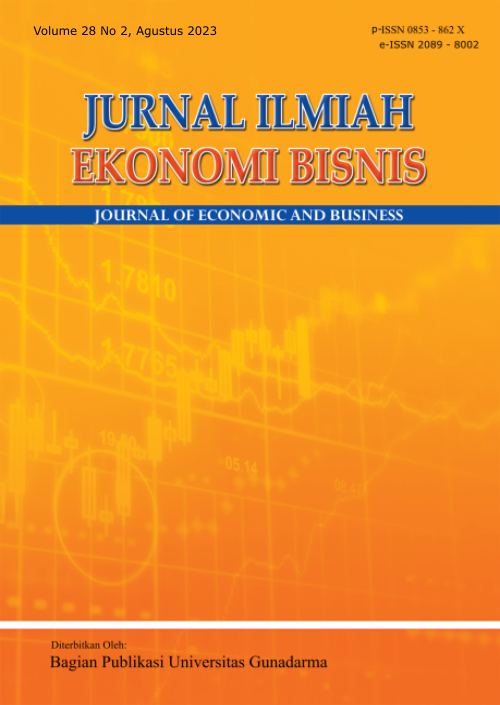DIGITAL MARKETING COMMUNICATION: A CASE STUDY OF COVID-19 PURCHASING DECISION RELATED TO SOCIAL MEDIA AND E-WOM
Gunadarma University
Indonesia
Gunadarma University
Indonesia
Gunadarma University
Indonesia

https://www.scopus.com/authid/detail.uri?authorId=55645367600
Gunadarma University
Indonesia
Abstract
The COVID-19 pandemic that occurred all across the globe affected the economy. The firm is responsible for promotions, and clients use different types of technology to make purchases. Digital marketing employs social media to promote a product using electronic communication tools, which assist customers in making better-educated buying choices and persuade them to purchase a product or service. This study used purposeful sampling to acquire data, and the sample size was computed using answers from 441 participants who completed online surveys. Participants must be at least 20 years old and active purchasers in the retail internet industry. The suggestion indicates that customers may obtain a product or service via social media or e-WOM. Our SEM-based analysis revealed conformity with the value CFI is 0.954, the value RFI is 0.918, the value NFI is 0.931, and the value RMSEA is 0.066. Consequently, advertising using digital marketing on social media during the COVID-19 epidemic has substantially influenced consumers' purchasing decisions.
Keywords
References
Abler, C. (2015). The cuture of content and digital transformation in the entreprise. In 3M Global eTransformation.
Ali, B. J., & Anwar, G. (2021). Marketing Strategy: Pricing strategies and its influence on consumer purchasing decision. International Journal of Rural Development, Environment and Health Research, 5(2), 26–39. https://doi.org/10.22161/ijreh.5.2.4
An, H. S., Chung, C., & Muk, A. (2020). The Effects of Social Media WOM and Fan Pages on Young Americans ’ Intention to Purchase Foreign Pop. International Journal of Business & Applied Sciences, 9(3), 1–16.
Arta, I. G. S., & Yasa, N. N. K. (2019). The Role of Purchase Intention on Mediating The Relationship of E-Wom and E-Wom Credibility to Purchase Decision. Russian Journal of Agricultural and Socio-Economic Sciences, 86(2), 33–39. https://doi.org/10.18551/rjoas.2019-02.06
Asghar, S., & Mahmud, B. (2020). Impact of Efficient Logistics and E-WOM regarding Online Purchase Intentions of University Students in Karachi. IOP Conference Series: Materials Science and Engineering, 780(6). https://doi.org/10.1088/1757-899X/780/6/062015
Balakrishnan, B. K. P. D., Dahnil, M. I., & Yi, W. J. (2014). The Impact of Social Media Marketing Medium toward Purchase Intention and Brand Loyalty among Generation Y. In Procedia - Social and Behavioral Sciences (pp. 177–185). https://doi.org/10.1016/j.sbspro.2014.07.032
Bishop, T. (2017). As programmatic advertising becomes the new normal, how can advertisers create greater consumer engagement and publishers ensure greater return? Journal of Digital & Social Media Marketing, 5, 1–12. Retrieved from https://www.ingentaconnect.com/content/hsp/jdsmm/2017/00000005/00000001/art00002
Cronbach, L. J. (1951). Coefficient alpha and the internal structure of tests. Psychometrika, 16(3), 297–334. https://doi.org/10.1007/BF02310555
Dulek, B., & Aydin, I. (2020). Effect Of Social Media Marketing On E-Wom, Brand Loyalty, And Purchase Intent. Bingöl Üniversitesi Sosyal Bilimler Enstitüsü Dergisi, 20, 271–288.
El-Baz, B. E.-S., Elseidi, R. I., & El-Maniaway, A. M. (2018). Influence of Electronic Word of Mouth (e-WOM) on Brand Credibility and Egyptian Consumers’ Purchase Intentions. International Journal of Online Marketing, 8(4), 1–14. https://doi.org/10.4018/ijom.2018100101
Georgi, D., Ducu, S., & Tuzovic, S. (2016). Acceptance and Adoption of Online-Received Recommendations on Social Media Platforms: An Empirical Investigation. In Developments in Marketing Science: Proceedings of the Academy of Marketing Science (pp. 231–233). https://doi.org/10.1007/978-3-319-24148-7_70
Ghosh, A., Varshney, S., & Venugopal, P. (2014). Social Media WOM: Definition, Consequences and Inter-relationships. Management and Labour Studies, 39(3), 293–308. https://doi.org/10.1177/0258042X15577899
Hair, J. F., Black, W. C., Babin, B. J., & Anderson, R. E. (2010). Multivariate Data Analysis. Vectors, 417(1–2), 280–290. https://doi.org/10.1016/j.ijpharm.2011.02.019
Hua, L. Y., Ramayah, T., Ping, T. A., & Jacky, C. J. H. (2017). Social Media as a Tool to Help Select Tourism Destinations: The Case of Malaysia. Information Systems Management, 34(3), 265–279. https://doi.org/10.1080/10580530.2017.1330004
Hudson, S., Huang, L., Roth, M. S., & Madden, T. J. (2015). The influence of social media interactions on consumer-brand relationships: A three-country study of brand perceptions and marketing behaviors. International Journal of Research in Marketing, 33(1), 7–41. https://doi.org/10.1016/j.ijresmar.2015.06.004
Ibrahim, R. A., & Wella, W. (2020). e-WOM: Buy or No Buy? Ultima InfoSys : Jurnal Ilmu Sistem Informasi, 11(1), 51–56. https://doi.org/10.31937/si.v9i1.1500
Lages, L. F., Jap, S. D., & Griffith, D. A. (2008). The role of past performance in export ventures: A short-term reactive approach. Journal of International Business Studies, 39(2), 304–325. https://doi.org/10.1057/palgrave.jibs.8400339
Luo, C., Wang, Y., Wu, N., Liang, X., & Guo, Y. (2014). The influence of eWOM and editor information on information usefulness in virtual community. Proceedings - Pacific Asia Conference on Information Systems, PACIS 2014.
Ma, L., Sun, B., & Kekre, S. (2015). The squeaky wheel gets the grease-an empirical analysis of customer voice and firm intervention on twitter. Marketing Science, 34(5), 627–645. https://doi.org/10.1287/mksc.2015.0912
Masodah, M., Musa, P., Pratiwi, E., & Murtiasih, S. (2019). Purchase Decision and Social Media in Indonesian Context: Moderating Effect of Gender, Income, and Intergenerational. Asian Business and Economics International Conference (ABEIC). Chuncheon, Gangwon-do, South Korea.
Matute, J., Polo-Redondo, Y., & Utrillas, A. (2015). The influence of EWOM characteristics on online repurchase intention: Mediating roles of trust and perceived usefulness. Online Information Review, 40(7), 1090–1110. https://doi.org/10.1108/OIR-11-2015-0373
Mentoh, M. A. Bin, & Suki, N. M. (2017). Conceptual study of the impacts of electronic-words-of-mouth (E-WOM) on consumers’ continuance intention and brand loyalty of islamic insurance (Takaful). Advanced Science Letters, 23(9), 8446–8449. https://doi.org/10.1166/asl.2017.9908
Nunnally, J., & Bernstein, I. (1994). Psychometric theory (3rd ed.). Journal of Psychoeducational Assessment. Vanderbill University.
Nurjaman, K. (2021). MSMEs Marketing Strategy with the Use of Social-Media in the COVID-19 Pandemic Era. International Journal of Science and Society, 3(4), 203–211. https://doi.org/10.54783/ijsoc.v3i4.406
Oraedu, C., Izogo, E. E., Nnabuko, J., & Ogba, I. E. (2021). Understanding electronic and face-to-face word-of-mouth influencers: an emerging market perspective. Management Research Review, 44(1), 112–132. https://doi.org/10.1108/MRR-02-2020-0066
Park, J., Hyun, H., & Thavisay, T. (2021). A study of antecedents and outcomes of social media WOM towards luxury brand purchase intention. Journal of Retailing and Consumer Services, 58. https://doi.org/10.1016/j.jretconser.2020.102272
Pasternak, O. (2017). Electronic word-of-mouth in online brand communities: drivers and outcomes. PQDT - UK & Ireland. Retrieved from http://search.proquest.com.ezp-prod1.hul.harvard.edu/docview/1937398243?accountid=11311%0Ahttps://hollis.harvard.edu/openurl/01HVD/HVD_URL??url_ver=Z39.88-2004&rft_val_fmt=info:ofi/fmt:kev:mtx:dissertation&genre=dissertations+%26+theses&sid=ProQ:ProQuest+
Penz, E., Zablocki, A., & Simbrunner, P. (2018). The Influence on Need for Cognition, Web Expertise and Trust on Online and Offline Information Search Behaviour: An Abstract. In Developments in Marketing Science: Proceedings of the Academy of Marketing Science (p. 277). https://doi.org/10.1007/978-3-319-66023-3_103
Pradhana, C. A., Suliantoro, H., & Susanty, A. (2021). Conceptual model of relationship between trust, perceived risk, price dispersion, e-WOM, perceived value, and online transaction intention. Proceedings of the International Conference on Industrial Engineering and Operations Management, 2118–2128.
Prasad, S., Gupta, I. C., & Totala, N. K. (2017). Social media usage, electronic word of mouth and purchase-decision involvement. Asia-Pacific Journal of Business Administration, 9(1), 134–145. https://doi.org/10.1108/APJBA-06-2016-0063
Purnama, R. (2020, September 20). Corona, Mitsubishi Employee Salaries Reduce of 30 Percent [Corona, Mitsubishi Potong Gaji Karyawan hingga 30 Persen]. News CNN Indonesia. Retrieved from https://www.cnnindonesia.com/teknologi/20200427191730-384-497806/corona-mitsubishi-potong-gaji-karyawan-hingga-30-persen
Rusli, C. A., & Mulyandi, M. R. (2019). Pengaruh Penggunaan Media Sosial, Electronic Word of Mouth (EWOM) terhadap Keputusan Pembelian Konsumen dan Dimediasi oleh Kepercayaan. 149–158. https://doi.org/10.33510/slki.2019.149-158
Sanjaya, S., & Budiono, H. (2021). Pengaruh Penggunaan Sosial Media Dan E-Wom Terhadap Keputusan Pembelian Di Mediasi Kepercayaan. Jurnal Manajerial Dan Kewirausahaan, 3(4), 1147. https://doi.org/10.24912/jmk.v3i4.13510
Sudarwan, I. A. (2020). Mitsubishi and Nissan dealers predict decline in revenue and profit [Dealer Mitsubishi dan Nissan Prediksikan Penurunan Pendapatan dan Laba]. News Bisnis.Com. Retrieved from https://market.bisnis.com/read/20200525/192/1244575/dealer-mitsubishi-dan-nissan-prediksikan-penurunan-pendapatan-dan-laba
Weitzl, W., Zniva, R., & Beldad, A. (2016). It’s All a Matter of Trust: The Importance and Role of Consumer Trust in E-WOM. AMA Winter Educators’ Conference Proceedings, Vol. 27, p. C-105-C-106. Retrieved from http://search.ebscohost.com/login.aspx?direct=true&db=bth&AN=120167779〈=pt-br&site=ehost-live
Yan, Q., Zhou, S., Zhang, X., & Li, Y. (2019). A system dynamics model of online stores’ sales: Positive and negative E-WOM and promotion perspective. Sustainability (Switzerland), 11(21). https://doi.org/10.3390/su11216045
Yeap, J. A. L., Ignatius, J., & Ramayah, T. (2014). Determining consumers’ most preferred eWOM platform for movie reviews: A fuzzy analytic hierarchy process approach. Computers in Human Behavior, 3(1), 250–258. https://doi.org/10.1016/j.chb.2013.10.034
Yudhistira, P. G. A. (2018). The Effect of E-WOM on Social Media Instagram Toward The Decision To Visit Labuan Bajo. Journal of Business on Hospitality and Tourism, 4(2), 140. https://doi.org/10.22334/jbhost.v4i2.117


